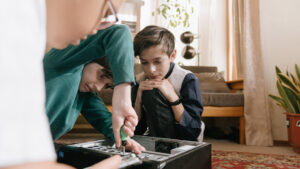Understanding Reflective Thinking
Reflective thinking is one of the essential cognitive skills. The ability to reflect and take corrective action is one reason why humanity has progressed so far.
It is one of the vital life skills that your kid will need. It is also a skill that they can apply in STEM education and robotics and coding for kids. Reflecting is not reacting immediately to something. It is maintaining a representation of the problem in mind, remembering it for analysis later, and then deciding the next course of action.
Reflection not only includes thinking about the problem. It also involves thinking about how the kid approached the problem. So, it is thinking about the thinking process. Therefore reflection is also referred to as a metacognition process.
Reflection ensures every step your kid makes is a conscious one. It acts as a guiding tool for behavior and is closely associated with executive function.
The Process:
The process of reflective thinking starts with a proper plan to remember things. It involves deciding which aspect of the problem to focus upon.
The next step is to form mental representations in the mind of those aspects and to retrieve those representations later on for taking further action.
Talking and discussing the problem helps in the process of reflection as it becomes easy to store representations and retrieve them from memory.
Engineering Design Process

In STEM education which involves activities on robotics for kids and coding for kids, reflective thinking is required as part of the problem-solving framework that’s used in engineering design.
Engineering refers to the use of STEM concepts to solve real-world problems, and engineering design is the process of using engineering to find solutions. Reflective thinking, thus, becomes essential to succeed in the STEM field.
Reflection is thinking and evaluating something. It compares what we had set out to achieve and what we achieved. You can reflect on the strategy before embarking on solving a problem or measuring the success of a particular strategy after applying it.
In their book Emergent Engineers, authors Agni Stone MacDonald, Kristen Wendell, Anne Douglas, and Mary Lu Love list specific tasks that young children should do to apply engineering design.
You can make your kid follow this process when engaged in STEM activities such as robotics for kids and coding for kids.
1.Think About It
Thinking about the problem is the first step. Make your kid study the situation by reading and talking about the issue. It also involves searching for other similar problems and existing solutions, what are the wants of the people who are facing the problem, deciding on the approach to solving the problem, and designing, modeling, and making predictions about the solutions. The questions to ask are about the goals and constraints in terms of resources and time.
2.Try It
Trying is essentially prototyping. It is building something with the available materials, an artifact that will solve the problem. You can make use of robotic play kit available in the market with which kids can try building robot toys and prototypes.
3.Fix It
Fixing is putting the artifact into action and testing if it solves the problem. Kids must study the test result, and improvements, if any, must be made.
4.Share it
Sharing the final solution or artifact with others is the final step. It also involves documenting the solution steps, reflecting on the entire design process, and how they did it. Your kids can share their solutions with you.
The Importance of Reflective Thinking

As we mentioned above, reflective thinking is an evaluation process. That’s what engineers and scientists usually do when investigating a problem. They evaluate their actions and the data gathered to ascertain if they are on the right path to the solution.
They evaluate to gather evidence to decide their further course of action. Reflective thinking entails forming judgments about the problem.
For your kid who is engaged in robotics and coding for kids, it means constantly rethinking and changing strategies when needed. As they are exposed to new knowledge, they evaluate the data and determine whether there is a need to change direction.
Reflective thinking involves relating new knowledge to prior understanding by remembering and forming connections. Since reflecting is a metacognition process, it requires kids to think about their problem-solving strategies and learning process, which helps them improve and grow.
Similarly, when your child is thinking reflectively, it means he is not applying a one size fits all strategy. They choose the most effective approach or course of action for a given situation.
Thus, reflective thinking involves critical thinking, analyzing, making judgements, and solving problems. All of these are part of higher-order thinking skills.
Strategies to Promote Reflective Thinking

As a parent, you can help your child develop reflective thinking. When kids talk and converse about the problem with you, they reflect on their activities. Offer them patient listening. Ask probing questions about how they solved a particular STEM problem, and follow up on the kids’ responses.
Similarly, you can also facilitate the development of metacognition skills in your kids by encouraging them to think about their strategies and learning methods. Documenting the child’s responses by writing them down can create a permanent record that the kid can return to for reflection.
On a concluding note, it can be said that reflection is the backbone of engineering, science and mathematics. Both thrive on evidence that can be observed and evaluated, which underlines the importance of reflective thinking. Without reflection and course correction, no meaningful progress can be made.
Creating a learning environment conducive to reflective thinking is vital in your kids’ STEM learning journey. Next time your kid is playing with robot kits, ask probing questions to your child and let them think and reflect. Sometimes a tiny pause is needed to travel a long way.

